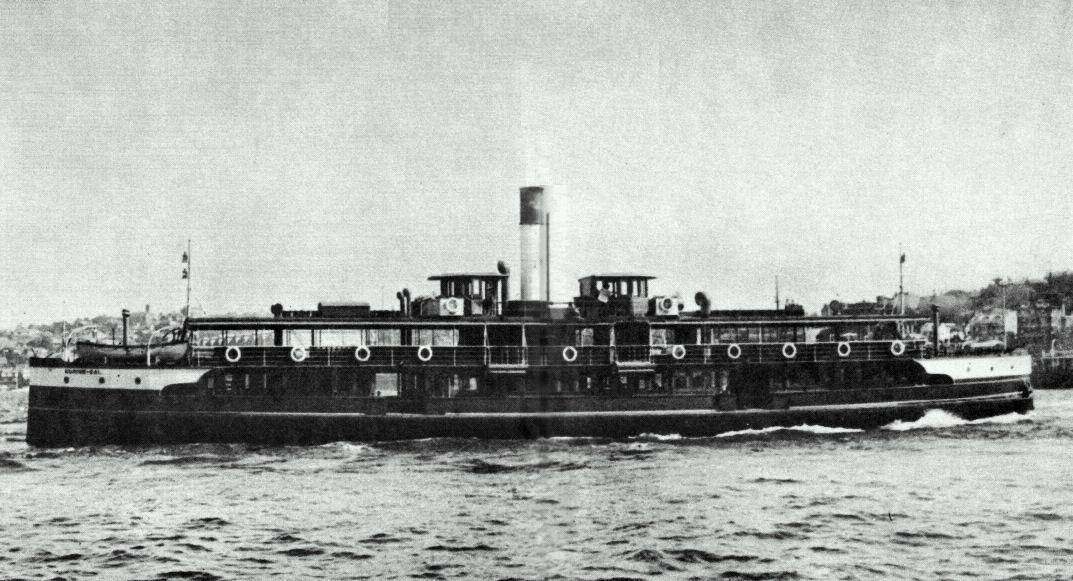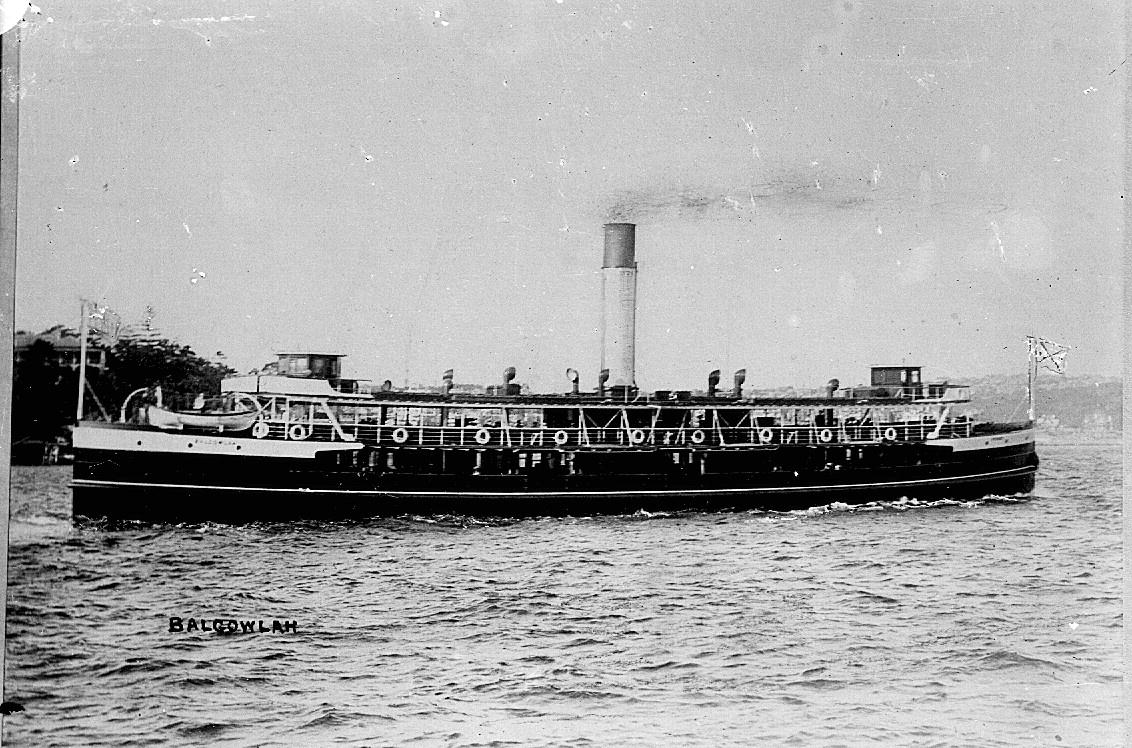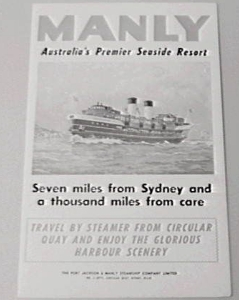|
Bellubera
Bellubera was a ferry operated by the Port Jackson & Manly Steamship Company on the Manly service. Launched in 1910, she was the third of six "Binngarra-type" vessels. Upon her 1936 conversion from steam power, she became the first diesel-electric vessel in Australia. She was decommissioned in 1973, and scuttled at sea in 1980. Due to many misfortunes in her 63-year service life, she was nicknamed the ''Hoodoo Ship''. Two of her masters died at the wheel, two crew members died when she was gutted by fire in 1936, and the owner of a motor launch was killed when the ''Bellubera'' ran it down and sank her. The name "bellubera" is thought to be an Australian Aboriginal word meaning "pretty lady" or "beautiful woman". Background The Port Jackson & Manly Steamship Company's fleet transitioned comparatively late to screw propelled vessels and the fleet comprised mostly paddle steamers until the early years of the twentieth century. The difficulty of turning in the narrow bays of Sy ... [...More Info...] [...Related Items...] OR: [Wikipedia] [Google] [Baidu] |
MV North Head
The MV ''North Head'' (formerly SS ''Barrenjoey'') was a ferry operated by the Port Jackson & Manly Steamship Company and its successors on the Manly service from 1913 until 1985. The vessel was launched as ''Barrenjoey'', a steamer and one of the six ''Binngarra''-type Manly ferries which were built between 1905 and 1922. In 1951, she was converted to diesel-electric power, completely rebuilt and renamed ''North Head''. She was removed from service in 1985 following the introduction of the ''Freshwater''-class ferries. She spent time in Hobart as a floating restaurant and, in 2000, she was taken to Cairns where she remains grounded and in deteriorating condition. The name "Barrenjoey" was taken from the headland at the northern tip of Pittwater. "North Head" is the northern headland at the entrance to Sydney Harbour. Background The Port Jackson & Manly Steamship Company's fleet transitioned comparatively late to screw propelled vessels and the fleet comprised mostly ... [...More Info...] [...Related Items...] OR: [Wikipedia] [Google] [Baidu] |
SS Balgowlah
SS ''Balgowlah'' was a ferry on Sydney Harbour operated by the Port Jackson & Manly Steamship Company on the Manly service from 1912 until 1951. Background The Port Jackson & Manly Steamship Company's fleet transitioned comparatively late to screw propelled vessels and the fleet comprised mostly paddle steamers until the early years of the twentieth century. The difficulty of turning in the narrow bays of Sydney Harbour - particularly in the busy Circular Quay terminus in Sydney Cove - required the use of double-ended vessels. However, a double-ended screw configuration was particularly difficult for the fine bows that Manly ferries required for both speed and heavy seas. Further, a propeller at the leading forward end of a vessel reduced speed considerably. In the prosperous early twentieth century, this speed drawback was overcome by increasing engine size and power. The first screw ferries on the Manly run were two innovative Walter Reeks–designed vessels; the ''SS Manly ... [...More Info...] [...Related Items...] OR: [Wikipedia] [Google] [Baidu] |
Baragoola
MV ''Baragoola'' was a ferry formerly operated by the Port Jackson & Manly Steamship Company and its successors on the Manly service. The sixth and final of the -type Manly ferries, the vessel entered service in 1922. Built with a triple-expansion steam engine, she was converted to diesel-electric propulsion in 1961. Since its decommissioning as a ferry in 1983, the vessel had a number of owners who attempted to find a new role and restore it. In 2003, it was laid up at Balls Head Bay on the north side of Sydney Harbour as attempts to restore the vessel continued. However, in January 2022, she sank at her mooring alongside the Balls Head Coal Loader, with the decision then made that the vessel would be scrapped. ''Baragoola'' is an Australian Aboriginal word for "flood tide". Background The Port Jackson & Manly Steamship Company's fleet transitioned comparatively late to screw-propelled vessels and the fleet comprised mostly paddle steamers until the early years of the t ... [...More Info...] [...Related Items...] OR: [Wikipedia] [Google] [Baidu] |
Burra-Bra
''Burra Bra'' was a Manly ferry on Sydney Harbour that operated by the Port Jackson & Manly Steamship Company from 1908 until 1940, before being requisitioned by the Royal Australian Navy for use as an anti-submarine training vessel and target tow during World War II. "Burra-Bra" is an Australian Aboriginal name for The Spit in northern Sydney. Background The Port Jackson & Manly Steamship Company's fleet transitioned comparatively late to screw propelled vessels and the fleet comprised mostly paddle steamers until the early years of the twentieth century. The difficulty of turning in the narrow bays of Sydney Harbour - particularly in the busy Circular Quay terminus in Sydney Cove - required the use of double-ended vessels. However, a double-ended screw configuration was particularly difficult for the fine bows that Manly ferries required for both speed and heavy seas. Further, a propeller at the leading forward end of a vessel reduced speed considerably. In the prosperou ... [...More Info...] [...Related Items...] OR: [Wikipedia] [Google] [Baidu] |
HMAS Burra Bra
''Burra Bra'' was a Manly ferry on Sydney Harbour that operated by the Port Jackson & Manly Steamship Company from 1908 until 1940, before being requisitioned by the Royal Australian Navy for use as an anti-submarine training vessel and target tow during World War II. "Burra-Bra" is an Australian Aboriginal name for The Spit in northern Sydney. Background The Port Jackson & Manly Steamship Company's fleet transitioned comparatively late to screw propelled vessels and the fleet comprised mostly paddle steamers until the early years of the twentieth century. The difficulty of turning in the narrow bays of Sydney Harbour - particularly in the busy Circular Quay terminus in Sydney Cove - required the use of double-ended vessels. However, a double-ended screw configuration was particularly difficult for the fine bows that Manly ferries required for both speed and heavy seas. Further, a propeller at the leading forward end of a vessel reduced speed considerably. In the prosperou ... [...More Info...] [...Related Items...] OR: [Wikipedia] [Google] [Baidu] |
Port Jackson & Manly Steamship Company
The Port Jackson and Manly Steamship Company (PJ&MSC) was a publicly listed company that operated the Manly ferries in Sydney, Australia. After being taken over by Brambles Industries, the ferry service was eventually taken over by the State Government and is now part of Sydney Ferries. The company is notable for coining the expression about Manly being "Seven miles from Sydney and a thousand miles from care" and for promoting development in the Manly and Pittwater / Broken Bay areas. Formation The history of the PJ&MSC is entwined with the history of Manly itself. Manly had been envisaged as a seaside resort by Henry Gilbert Smith in the 1850s. Initially Smith had chartered a paddle steamer to Manly and other vessels visited on an ad hoc "excursion" basis. Smith built a wharf in 1855 and eventually acquired an interest in steamers himself and soon more regular services to Manly had commenced. By 1873 Smith had sold the lease to the wharf and his share of the steamers ... [...More Info...] [...Related Items...] OR: [Wikipedia] [Google] [Baidu] |
Manly Ferry Services
Manly ferry services (numbered F1) operate on Sydney Harbour connecting the Sydney suburb of Manly with Circular Quay in the CBD a journey of seven nautical miles. History In 1853, Henry Gilbert Smith chartered the wooden paddle wheeler '' Brothers'' to bring people to the Manly area and thus boost the value of the subdivision of his land holdings near the Corso. The Manly area with its beaches and bays became a popular weekend destination and more ferries were chartered including by a local hotel owner. By 1855, the paddle steamer ''Emu'' (I) provided two daily weekday trips. ''Emu'' was followed by ''Black Swan'' and ''Pelican''. In 1859, the first double-ended ferry, '' Phantom'' commenced the service. She was a success, and the double-ended configuration remains the standard on the Manly route through to the present-day. Weekends and holidays were even busier than week days, and extra boats and tugs were put into service often as charters, including ''Goolwa'', ''B ... [...More Info...] [...Related Items...] OR: [Wikipedia] [Google] [Baidu] |
Binngarra
''Binngarra'' was a ferry operated by Port Jackson & Manly Steamship Company on the Manly service. Launched in 1905, she was the first of six similar vessels built for the company–the ''Binngarra'' class—the success of which saw three of her sister vessels serving through to the 1970s and 1980s. Built by Mort's Dock and Engineering Co Ltd, in Woolwich, she was a double-ended screw steamer with steel hull and timber superstructure. She was decommissioned from ferry service in 1930. "Binngarra" is thought to be an Australia Aboriginal word for "spring" or "returning". It is sometimes misspelled as "Bingarra". Background The Port Jackson & Manly Steamship Company's fleet transitioned comparatively late to screw propelled vessels and the fleet comprised mostly paddle steamers until the early years of the twentieth century. The difficulty of turning in the narrow bays of Sydney Harbour - particularly in the busy Circular Quay terminus in Sydney Cove - required the use of dou ... [...More Info...] [...Related Items...] OR: [Wikipedia] [Google] [Baidu] |
Manly Ferry Wharf
Manly Wharf is a heritage-listed passenger terminal wharf and recreational area located at West Esplanade and serving Manly, a Sydney suburb in the Northern Beaches Council local government area of New South Wales, Australia. Since the 1850s, it has served as the Manly embarkation and disembarkation point for the Manly to Sydney ferry service. The wharf has been redeveloped a number of times since the first structure was constructed in 1856. New facilities were added in the early 20th century, and it was rebuilt in a modernist style in the early 1940s, the basic form of which remains today. The wharf was added to the New South Wales State Heritage Register on 18 April 2000. In addition to passenger services, a cargo service was also run to Manly until the 1928-opening of the Spit Bridge. Following the closure of the cargo service, an amusement park, Manly Fun Pier, was opened on the east wharf in 1931 which closed prior to the 1990 redevelopment of the wharf. Services To ... [...More Info...] [...Related Items...] OR: [Wikipedia] [Google] [Baidu] |
Steam Engine
A steam engine is a heat engine that performs mechanical work using steam as its working fluid. The steam engine uses the force produced by steam pressure to push a piston back and forth inside a cylinder. This pushing force can be transformed, by a connecting rod and crank, into rotational force for work. The term "steam engine" is generally applied only to reciprocating engines as just described, not to the steam turbine. Steam engines are external combustion engines, where the working fluid is separated from the combustion products. The ideal thermodynamic cycle used to analyze this process is called the Rankine cycle. In general usage, the term ''steam engine'' can refer to either complete steam plants (including boilers etc.), such as railway steam locomotives and portable engines, or may refer to the piston or turbine machinery alone, as in the beam engine and stationary steam engine. Although steam-driven devices were known as early as the aeo ... [...More Info...] [...Related Items...] OR: [Wikipedia] [Google] [Baidu] |
British Thompson-Houston
British Thomson-Houston (BTH) was a British engineering and heavy industrial company, based at Rugby, Warwickshire, England, and founded as a subsidiary of the General Electric Company (GE) of Schenectady, New York, United States. They were known primarily for their electrical systems and steam turbines. BTH was taken into British ownership and amalgamated with the similar Metropolitan-Vickers company in 1928 to form Associated Electrical Industries (AEI), but the two brand identities were maintained until 1960. The holding company, AEI, later merged with GEC. In the 1960s AEI's apprenticeships were highly thought-of, both by the apprentices themselves and by their future employers, because they gave the participants valuable experience in the design, production and overall industrial management of a very wide range of electrical products. Over a hundred of the apprentices - who came to Rugby from all over the UK, and a few from abroad - lodged in the nearby Apprentices' Hoste ... [...More Info...] [...Related Items...] OR: [Wikipedia] [Google] [Baidu] |
Harland & Wolff
Harland & Wolff is a British shipbuilding company based in Belfast, Northern Ireland. It specialises in ship repair, shipbuilding and offshore construction. Harland & Wolff is famous for having built the majority of the ocean liners for the White Star Line, including ''Olympic''-class trio – , and HMHS ''Britannic''. Outside of White Star Line, other ships that have been built include the Royal Navy's ; Royal Mail Line's ''Andes''; Shaw, Savill & Albion's ; Union-Castle's ; and P&O's . Harland and Wolff's official history, ''Shipbuilders to the World'', was published in 1986. As of 2011, the expanding offshore wind power industry had been the prime focus, and 75% of the company's work was based on offshore renewable energy. Early history Harland & Wolff was formed in 1861 by Edward James Harland (1831–95) and Hamburg-born Gustav Wilhelm Wolff (1834–1913; he came to the UK at age 14). In 1858 Harland, then general manager, bought the small shipyard on '' ... [...More Info...] [...Related Items...] OR: [Wikipedia] [Google] [Baidu] |








